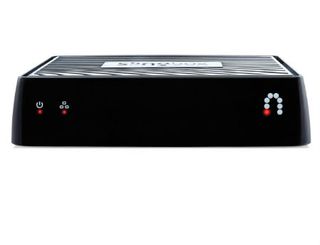Sling Media Targets The Mainstream

Aiming to bring its video place-shifting technologies and services to a wider audience while still catering to its existing tech-savvy customer base, Sling Media has introduced a new, less expensive baseline model and affixed a new name and new features to its current high-end model.
On the entry-level side, the more compact, eye-catching (and long-rumored) Slingbox M1 (pictured above) replaces the Slingbox 350, while the high-end Slingbox 500 has been recast as SlingTV and been paired with a significant software upgrade.
At $149.99, the M1, billed as a device for the “mainstream user,” comes with integrated dual-band 802.11n WiFi and support for a new, simplified Slingplayer app for PCs and Macs as well as for iOS and Android devices. The old Slingbox 350 model, by comparison, was more expensive ($175) and did not bake in WiFi.
The company’s new Slingplayer for Desktop app also allows users to set up Slingbox products across different devices, whether it's via PCs, Macs or the aforementioned mobile devices. Previously, users could watch place-shifted video on mobile devices but had to use a browswer running on a Mac or PC to set everything up.
Slingplayer for Desktop marks the return of an app-based option that historically was popular with Slingbox customers, said Michael Hawkey, SVP and GM of Sling Media. The new desktop app is free for Macs and PCs, but still runs $15 for iOS and Android. Sling Media will continue to offer a browser-based device set-up and configuration environment, though the company does not intend to add new features to it. According to the company, the new desktop app is designed to get users up and running in less than 10 minutes.
Hawkey said the M1 product and simplified set-up and configuration apps are part of a broader plan to target a larger mainstream consumer that goes beyond Sling Media’s traditional market of sports fans, travelers, and TV enthusiasts.
“I want it to be simple, easy, and used by all,” he said, noting that Sling Media will be backing the new product with a marketing campaign tailored for that broader demographic. “These people have devices, and they want to watch TV. I haven’t reached them before," Hawkey said.
Multichannel Newsletter
The smarter way to stay on top of the multichannel video marketplace. Sign up below.
Sling Media hasn’t revealed Slingbox sales figures, but there are “millions” of users in the market, he said.
And Sling Media isn’t ignoring those users, even as it uses the M1 to help it expand its addressable market.
Although the hardware of the $299.99 SlingTV (integrated WiFi, and HDMI output that can drive content and apps to the television) remains unchanged, the company hopes to make the product more attractive by rewriting the middleware and the operating system, and shifting to a richer, HTML5-based navigation, search and applications environment.
Sling Media will use that refreshed platform to deliver its menu of apps, including access to Blockbuster, the subscription-based DishWorld OTT video service, a recommendation engine called SlingCloud, the Rotten Tomatoes service, and Thuuz, a ratings service that tells viewers when a particular sporting event is trending based on its excitement level.
The new M1 will be available at retail stores, at Sling.com, and via Sling’s online retail partners such as Amazon.com and TigerDirect.com on July 20. The rebranded SlingTV product will become available in late August, the same time that existing Slingbox 500 customers will automatically receive the new SlingTV software.
